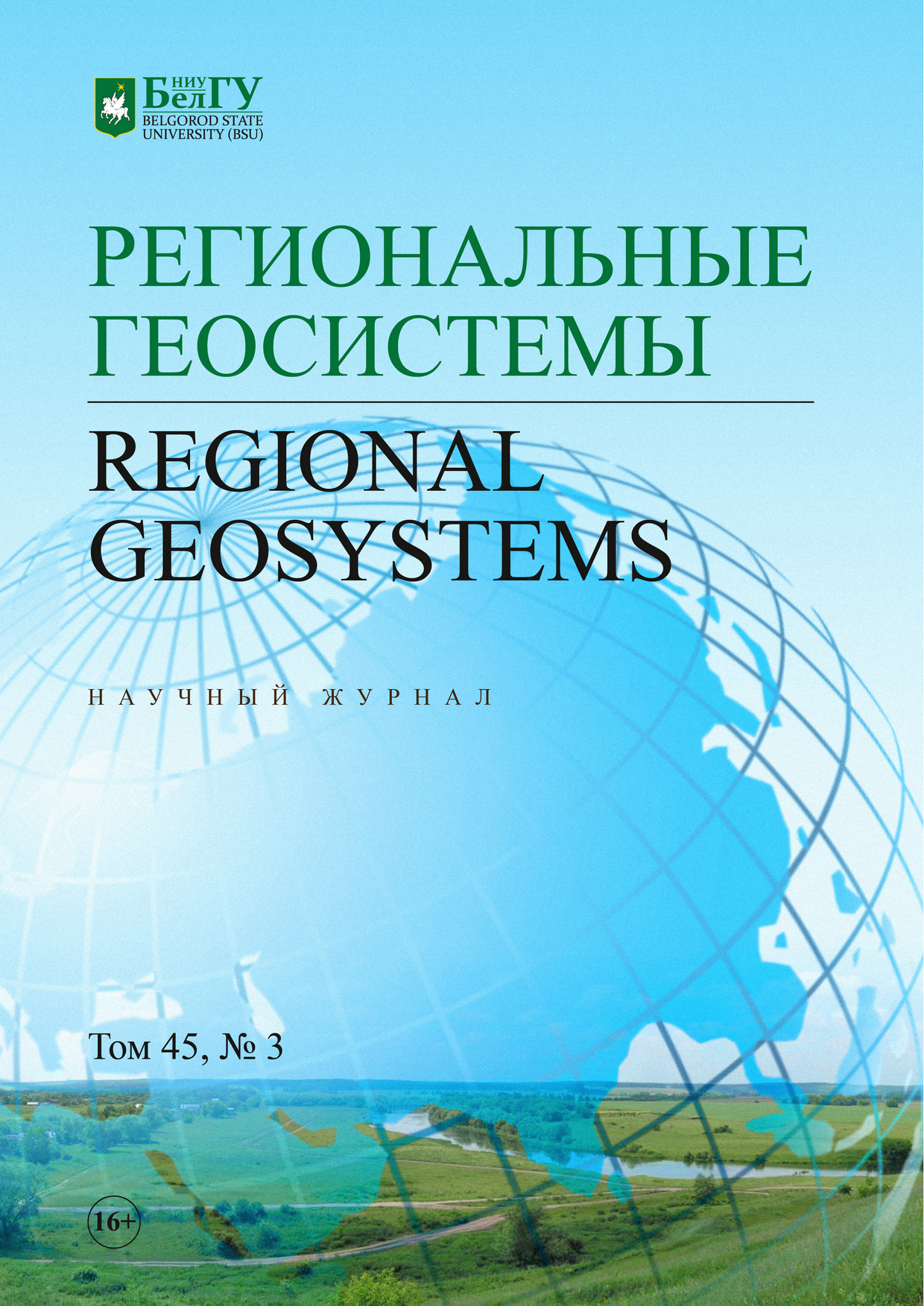On the origin of volcanic ash deposits on the territory of the Voronezh region
DOI:
https://doi.org/10.52575/2712-7443-2021-45-3-441-454Keywords:
Voronezh region, volcanic ash, meteorites, impactites, noble metalsAbstract
Our studies of the material composition of rocks of Quaternary and Neogene ages in the Voronezh region over the past three years have revealed very high concentrations of compounds of rare and noble metals, including iridium, which most likely got into sedimentary deposits from space objects. Collisions of the Earth with bodies from outer space led to large-scale climatic transformations, mass extinctions of representatives of the organic world. At the same time, insufficient attention is paid to the study of traces of impact events and the consequences of their impact on the natural environment of our planet. In this regard, the authors carried out a study of rocks considered to be volcanic ashes and their host deposits, occurring in geological sections near two settlements of the Voronezh region, in order to determine the material composition and environments of their formation. Investigations of the mineral and elemental composition of the "ashes" and their host rocks were carried out by X-ray diffraction and electron microscopic analyzes using the ICDD PDF-2 Siroguant databases and software Sietronics Pty Ltd. As a result of investigations, significant contents of iridium, osmium, platinum, gold, and rhenium were revealed in the layers taken for volcanic ash in both sections. X-ray amorphous silica is the main mineral phase in the Gorenka "ashes", and quartz in the Duvankinsky ones with the complete absence of an X-ray amorphous component. Two kilometers north of the village of Aleksandrovka Donskaya (the former settlement of Duvanka) there are two craters with a diameter of about one kilometer each, which, in our opinion, formed on the basis of the results obtained, are formed due to explosive processes when the debris of the comet's nucleus falls to the Earth's surface. As a result of the ejection of material from the inner parts of the funnels, mixed with the material of the debris, two layers of "ash" were formed. On the basis of the obtained analytical results, with the involvement of literary sources, a conclusion was made about the impact events that took place in this territory. This interpretation of the research carried out in this area was carried out for the first time.
Downloads
References
Алексеенко В.А. 2011. Геоботанические исследования для решения ряда экологических задач и поисков месторождений полезных ископаемых. М., Логос, 244 с.
Ермолов В.А. 2008. Основы геологии. М., Издательство Московского государственного горного университета, 598 с.
Николаев В.А. 2006. Ландшафтоведение. М., Изд-во Географического факультета Московского государственного университета, 208 с.
Грищенко М.Н. 1976. Плейстоцен и голоцен бассейна Верхнего Дона. М., Наука, 229 с.
Дубянский А.А. 1935. Предварительные сведения о вулканическом пепле, залегающем в окрестностях г. Павловск (Воронежской области). Труды Центрального научно-исследовательского геолого-разведочного института (ЦНИГРИ), 39: 3–18.
Жабин А.В., Дубков А.А., Золотарёва Г.С., Кузнецов Ю.А. 2020. Импактиты в четвертичных отложениях Воронежской антеклизы. Недра Поволжья и Прикаспия, 102: 18–31. DOI: 10.24411/1997-8316-2020-11023.
Жабин А.В., Жабина А.А. 2019. Влияние импактных событий на глобальные изменения природной среды в позднем плейстоцене и голоцене. В кн.: Глобальные климатические изменения: региональные эффекты, модели, прогнозы. Материалы международной научно-практической конференции, 3–5 октября 2019, Воронеж, Цифровая полиграфия, 1: 40–43.
Жабин А.В., Савко А.Д., Сиротин В.И. 2008. Глинистые минералы осадочного чехла Воронежской антеклизы. Труды Научно-исследовательского института геологии Воронежского государственного университета, 51: 1–92.
Иосифова Ю.И. 1992. О возрасте пеплосодержащей толщи в разрезе у с. Горелка Воронежской области. Стратиграфия фанерозоя центра Восточно-Европейской платформы, 36–59.
Мильков Ф.Н. 1977. Генезис и генетические ряды ландшафтных комплексов. В кн.: Землеведение. Сборник Московского общества испытателей природы. Новая серия. Т. 12. М., Изд-во Московского университета: 5–11.
Муртазов А.К. 2004. Экология околоземного космического пространства. М., ФИЗМАТЛИТ, 304 c.
Савко А.Д., Мануковский С.В., Мизин А.И. 2001. Литология и фации донеогеновых отложений Воронежской антеклизы. Труды научно-исследовательского института геологии Воронежского государственного университета, 3: 1–201.
Солнцев Н.А. 2001. Учение о ландшафте (избранные труды). М., Изд-во Московского университета, 384 с.
Холмовой Г.В. 2008. Морфоскопические особенности неогеновых и четвертичных вулканических пеплов Воронежской области. Вестник Воронежского госуниверситета. Серия: Геология, 1: 19–22.
Холмовой Г.В. 2013. Геологическая карта дочетвертичных отложений. В кн.: Экологогеографический Атлас-книга Воронежской области. Воронеж, Изд-во Воронежского государственного университета: 40–42.
Collins G.S., Melosh H.J., Osinski G.R. 2012. The Impact-Cratering Process. Elements, 8 (1): 25–30. DOI: 10.2113/gselements.8.1.25.
Koeberl C., Claeys P., Hecht L., McDonald I. 2012. Geochemistry of Impactites. Elements, 8 (1): 37–42. DOI: 10.2113/gselements.8.1.37.
Damuth J. 1981. Popylation density and body size in mammals. Nature, 290: 699–700. DOI: 10.1038/290699a0.
Firestone R.B., West A., Kennett J.R., Becker L., Bunch T.E., Revay Z.S., Schultz P.H., Belgya T., Kennett D.J., Erlandson J.M., Dickenson O.J., Goodyear A.C., Harris R.S., Howard G.A., Kloosterman J.B., Lechler P., Mayewski P.A., Montgomery J., Poreda R., Darrah T., Que Hee S.S., Smith A.R., Stich A., Topping W., Wittke J.H., Wolbach W.S. 2007. Evidence for an extraterrestrial im-pact 12900 years ago that contributed to the megafaunal extinctions and the Younger Dryas cooling. Proceedings of the National Academy of Sciences, 104 (41): 16016–16021. DOI: 10.1073/pnas.0706977104.
Abstract views: 346
Share
Published
How to Cite
Issue
Section
Copyright (c) 2021 REGIONAL GEOSYSTEMS

This work is licensed under a Creative Commons Attribution 4.0 International License.


